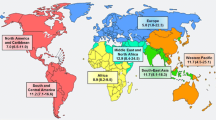Abstract
We evaluated the association between indicators of fetal growth and hospitalization with infectious disease during childhood in a cohort of 10,400 newborns. The cohort was based on children born to mothers who at about 36 weeks of gestation attended the midwife centres in Odense and Aalborg, Denmark for a routine examination. Women were recruited to the study from April 1984 to April 1987. After linkage with the National Hospital Registry, the first hospitalization with infectious disease from 6 months up to 12 years of age was identified. The cumulative incidence of hospitalization with infectious disease during follow-up was 18.9%. Preterm birth was associated with an increased risk of being hospitalized with infections during childhood (incidence rate ratio: 1.67,95% CI: 1.33–2.10); low birth weight had a similar association, but only in preterm birth. Reduced birth length related to the head was correlated with an increased risk of hospitalization with infections. The effect of gestational age was mainly seen in the period close to the time of birth, but the children who were short at birth appeared to remain at increased risk throughout the age interval under analysis. In conclusion, the study suggests that preterm birth was the main factor underlying the association between low birth weight and the increased risk of hospitalization with infectious disease during childhood. However, it could not explain the increased risk in children who were short at birth.
Similar content being viewed by others
References
Kermack WO, McKendrick AG, McKinlay PL. Deathrates in Great Britain and Sweden. Lancet 1934; i: 698–703.
Forsdahl A. Are poor living conditions in childhood and adolescence an important risk factor for arteriosclerotic heart disease? Br J Prev Soc Med 1977; 31: 91–95.
Barker DJ. The fetal and infant origins of disease. Eur J Clin Invest 1995; 25: 457–463.
Leon DA. Fetal growth and adult disease. Eur J Clin Nutr 1998; 52(Suppl 1): S72–S78.
Barker DJ, Gluckman PD, Godfrey KM, Harding JE, Owens JA, Robinson JS. Fetal nutrition and cardiovascular disease in adult life. Lancet 1993; 341: 938–941.
Read JS, Troendle JF, Klebanoff MA. Infectious disease mortality among infants in the United States, 1983 through 1987. Am J Public Health 1997; 87: 192–198.
Read JS, Clemens JD, Klebanoff MA. Moderate low birth weight and infectious disease mortality during infancy and childhood. Am J Epidemiol 1994; 140: 721–733.
Victora CG, Smith PG, Vaughan JP, et al. Influence of birth weight on mortality from infectious diseases: A case–control study. Pediatrics 1988; 81: 807–811.
Muhlestein JB. Bacterial infections and atherosclerosis. J Investig Med 1998; 46: 396–402.
Gupta S, Camm AJ. Is there an infective aetiology to atherosclerosis? Drugs Aging 1998; 13: 1–7.
Mattila KJ, Valtonen VV, Nieminen MS, Asikainen S. Role of infection as a risk factor for atherosclerosis, myocardial infarction, and stroke. Clin Infect Dis 1998; 26: 719–734.
Olsen J, Pereira A, Olsen SF. Does maternal tobacco smoking modify the effect of alcohol on fetal growth? Am J Public Health 1991; 81: 69–73.
Olsen J, Frische G, Poulsen AO, Kirchheiner H. Changing smoking, drinking, and eating behaviour among pregnant women in Denmark. Evaluation of a health campaign in a local region. Scand J Soc Med 1989; 17: 277–280.
Wilcox MA, Johnson IR, Maynard PV, Smith SJ, Chilvers CE. The individualised birthweight ratio: A more logical outcome measure of pregnancy than birthweight alone. Br J Obstet Gynaecol 1993; 100: 342–347.
Nielsen GL, Sorensen HT, Pedersen AB, Sabroe S. Analyses of data quality in registries concerning diabetes mellitus – a comparison between a population based hospital discharge and an insulin prescription registry. J Med Syst 1996; 20: 1–10.
Sorensen HT. Regional administrative health registries as a resource in clinical epidemiology. Int J RiskSafety Med 1997; 10: 1–22.
Sorensen HT, Hansen I, Ejlersen E, Schonheyder HC, Hamburger H, Sabroe S. Identification of cases of meningococcal disease: Data quality in two Danish population-based information systems during a 14-year period. Int J RiskSafety Med 1995; 7: 179–189.
Gibson JJ, Alexander GR. Correlates of infant death frominfectious diarrhea in the southeastern United States. South Med J 1985; 78: 26–30.
Victora CG, Smith PG, Barros FC, Vaughan JP, Fuchs SC. Risk factors for deaths due to respiratory infections among Brazilian infants. Int J Epidemiol 1989; 18: 918–925.
Papadatos C, Papaevangelou G, Alexiou D, Mendris J. Immunoglobulin levels and gestational age. Biol Neonat 1969; 14: 365–373.
Evans HE, Akpata SO, Glass L. Serum immunoglobulin levels in premature and full-term infants. Am J Clin Pathol 1971; 56: 416–418.
Strunk RC, Fenton LJ, Gaines JA. Alternative pathway of complement activation in full term and premature infants. Pediatr Res 1979; 13: 641–643.
Cocchi P, Marianelli L. Phagocytosis and intracellular killing of Pseudomonas aeruginosa in premature infants. Helv Paediatr Acta 1967; 22: 110–118.
Barker DJ. Intrauterine programming of adult disease. Mol Med Today 1995; 1: 418–423.
Godfrey KM, Barker DJ. Maternal nutrition in relation to fetal and placental growth. Eur J Obstet Gynecol Reprod Biol 1995; 61: 15–22.
Chandra RK. Interactions between early nutrition and the immune system. Ciba Found Symp 1991; 156: 77–89.
Ferguson AC. Prolonged impairment of cellular immunity in children with intrauterine growth retardation. J Pediatr 1978; 93: 52–56.
Chandra RK, Ali SK, Kutty KM, Chandra S. Thymusdependent lymphocytes and delayed hypersensitivity in low birth weight infants. Biol Neonate 1977; 31: 15–18.
Author information
Authors and Affiliations
Rights and permissions
About this article
Cite this article
Yuan, W., Basso, O., Sorensen, H.T. et al. Indicators of fetal growth and infectious disease in childhood – a birth cohort with hospitalization as outcome. Eur J Epidemiol 17, 829–834 (2001). https://doi.org/10.1023/A:1015626329533
Issue Date:
DOI: https://doi.org/10.1023/A:1015626329533




